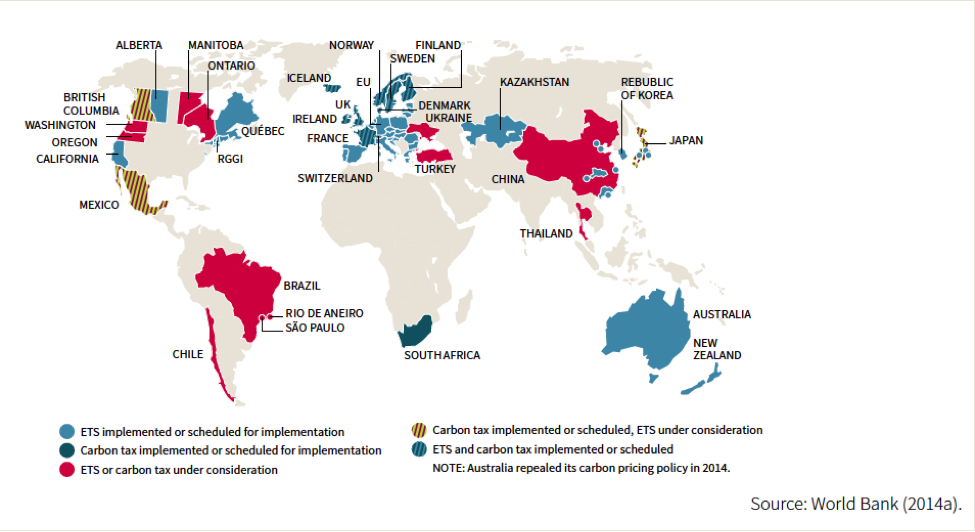By James Magnus-Johnston
The federal government has stated that if provinces don’t impose a price on carbon, it will impose its own price by 2018. Trudeau has stated that “if neither price nor cap and trade is in place by 2018, the government of Canada will implement a price in that jurisdiction.”
Eight out of ten provinces will be designing their own mechanism to collect and “recycle” revenues under the new “Pan Canadian Framework on Clean Growth and Climate Change.” While Saskatchewan and Manitoba have chosen not to sign for now, Manitoba Premier Brian Pallister has stated support for a carbon price. He is currently withholding adoption until an agreement is reached over long-term health care funding.
The Pan-Canadian Framework
Under the Pan-Canadian Framework, eight provinces have agreed to (a) put a price on carbon; (b) take complementary climate actions (including increasing efficiency standards and improving building codes); (c) take measures to adapt and build resilience to the impacts of climate change, and; (d) take actions to support clean technology development.
Provinces have a great degree of flexibility to decide what kind of carbon pricing system they will implement, and how the collected funds will be used.
Highlights of the Pan Canadian Framework:
- the federal government will impose a “pricing benchmark” of $10 a tonne in 2018
- the price will rise by $10 a year to reach $50 a tonne in 2022
- Provinces with cap-and-trade systems that have fluctuating prices must demonstrate that they have reduced emissions equivalent to what would be achieved by a tax
- Jurisdictions that do not implement their own carbon pricing policy will be subject to a federal carbon price
- All revenues from the carbon pricing will be returned to their jurisdiction of origin
BC and Alberta have adopted a carbon tax while Ontario, Quebec, and Nova Scotia have opted for a cap-and-trade system. Manitoba appears to be favouring a carbon tax (read more about the two options here).
Manitoba’s unique carbon profile and options
Manitoba’s GHG emissions

In a recent workshop on carbon pricing hosted by the EcoFiscal Commission, the government considered opportunities for a “made-in-Manitoba” approach.
Each jurisdiction has a unique carbon profile, and needs to govern its emissions accordingly. Manitoba’s largest sources of GHG emissions are the transportation and agriculture sectors (with “stationary combustion” or “buildings” coming in third), warranting an approach that carefully addresses the needs of those industries.
Those in attendance at the government workshop discussed the rationale for carbon pricing, the coverage of the policy, the stringency of the policy, different recycling options for the revenues, and complementary policies. Early signs are that the simplicity of a levy is preferable to the complexity of a carbon trading scheme, though there is no consensus yet.
Momentum and challenges surrounding carbon pricing
There has been some international momentum around carbon pricing, with many jurisdictions around the world having implemented or scheduled the implementation of a carbon price.

One of the main assumptions among proponents of carbon pricing is that the price will actually change behaviour in ways that truly reduce carbon emissions. Economist Mark Jaccard, of Simon Fraser University, is an expert on carbon pricing and policy. He and others have noted that after BC put a price on carbon, GHG emissions continued to rise, making it extremely difficult for the province to meet its own legislated target. He now prefers strong regulations that set clear and realistic guidelines for different industries, because unless the carbon tax is significant enough (to the tune of $200/tonne), it may have little effect.
Options for “revenue recycling”
There is some potential for change if collected revenues are recycled in ways that create green employment and education opportunities, deploy green technology for emissions reduction, and improve our ecological infrastructure. While there is often much hope placed in the development of new low carbon technology, there are some tools available today that would accelerate the transition to a low-carbon economy. From urban densification strategies to the adoption of consumer electric vehicles and more efficient waste management, there are steps we can take immediately to reduce emissions.
In Manitoba, we’re lucky to have a renewable grid powered by hydro, but reducing GHG emissions from transportation and agriculture will not be easy. A price on carbon has to be complemented with are clear regulations and assistance for industry where necessary.
Fairness and competitiveness considerations
There is an important concern over the fairness of a carbon tax, because a carbon tax is regressive, negatively affecting vulnerable households and communities that spend a disproportionate share of income on fossil fuel — particularly for transportation and home heating. Revenue recycling would therefore require a tax credit for Manitobans below the low income cut-off.
While there have been concerns voiced over the impact of a carbon price to national economic competitiveness as well, we can’t forget that there are astronomical costs associated with climate change, too. It has already cost Alberta $4.7 billion to cope with the 2013 floods, and we’re going to lose 18 million hectares of western Canadian forest due to an outbreak of the mountain pine beetle. The costs go up with each passing year, and are mainly paid by government as a response to extreme weather events. As cited by the EcoFiscal Commission, the OECD estimates that every dollar the industrialized world fails to invest in clean energy today will cost more than four dollars down the road. Either way, the costs of climate change will be passed on to consumers. The sooner we act, the better.
James Magnus-Johnston is the Co-Chair of Transition Winnipeg, which tabled a successful motion at the Canadian Community Economic Development Network – Manitoba policy summit to urge the Province of Manitoba to adopt a carbon levy and strong regulations.
Watch for for Part II of this blog – Options for Revenue Recycling and Climate Mitigation


